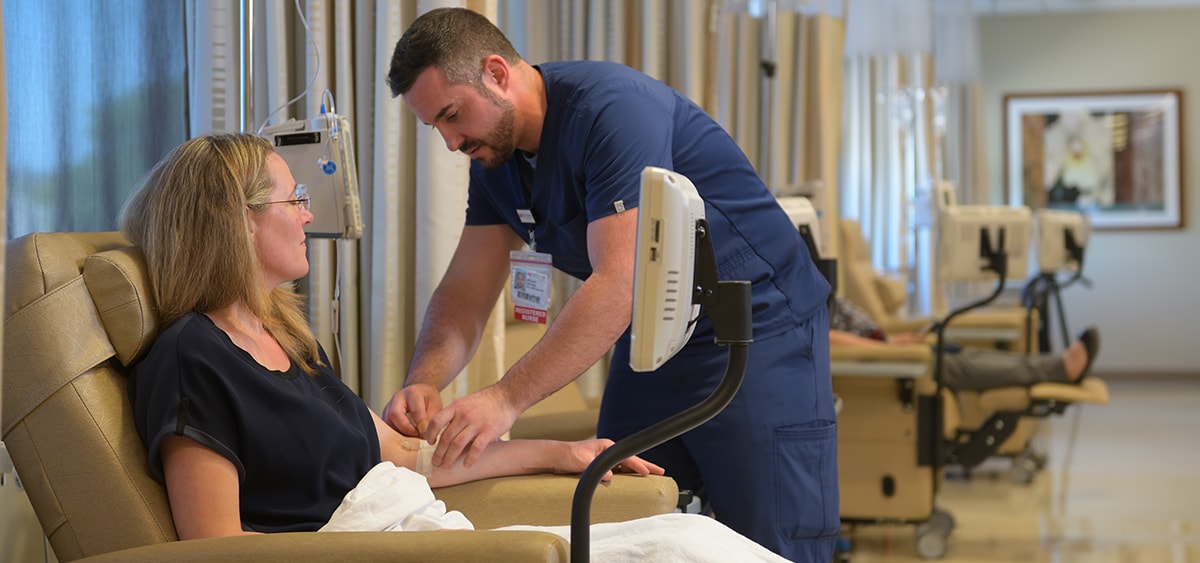
Catheters and Ports for Cancer Treatment: Your Questions Answered
-
Updated: February 13, 2020
After a cancer diagnosis, lots of decisions need to be made. One that many patients face is whether or not to have a catheter or a port—or both—inserted. These can be used for blood draws and intravenous (IV) chemotherapy treatments.
The idea of having something under their skin can make lots of people nervous. But there are certainly pros to having a port and/or catheter inserted. For one, they can make receiving treatment much easier. One of our infusion nurses at Fox Chase, Kathleen Hess, CNRN, took some time to answer a few common questions she hears about these devices.
Q: What are catheters?
A: A catheter is a long narrow tube made of soft plastic. Medical staff use catheters to put medication into a vein.
Nurses often give IV treatments by inserting a small needle into a catheter that’s in your forearm or hand. Then, at the end of the day, they can remove the catheter. Sometimes a catheter can stay in for two or three days if it’s comfortably and safely in the vein.
This type of catheter isn’t always the best option, however. Sometimes, depending on the patient and the medication received, a larger catheter is needed. It goes into a large vein in your upper arm or neck. And these larger catheters are often paired with a port.
Q: What’s a port?
A: A port is a small metal or plastic disc that’s connected to the catheter. Both the catheter and the port can be under the skin. Or sometimes the tip of the catheter is outside the body. When you’re not getting treatment, the tip is clamped or capped to keep it closed.
Q: How are ports inserted?
A: A surgeon or radiologist will place the port. They’ll use local anesthesia or medication to make you relax and feel sleepy. It’s a quick procedure with very little recovery.
Q: How do doctors decide what kind of catheter or port I need?
A: There are several kinds of catheters and ports. Your physician will make a recommendation based on several factors, including the kind of treatment you’ll receive and how long you’ll need it.
Q: What are the benefits of having a catheter and port for cancer treatment?
A: Catheters and ports can save you from being stuck with a needle over and over. This is especially helpful if you have small or damaged veins. “They can also reduce the risk of tissue damage from a medication that could leak outside of a vein,” said Kathleen Hess, OCN, RN, an infusion nurse at Fox Chase Cancer Center.
Having a catheter and a port may enable you to receive treatments that last longer than one day. And they allow for more than one medication at a time to be infused, if needed. A catheter/port combo can even mean blood tests and chemo can be done the same day with just one needle stick.
Q: Are there any risks with catheters and ports?
A: As with other medical devices and treatments, catheters have potential side effects and risks. Proper maintenance can help you minimize these risks.
“People hear a port is going into the biggest vein in their body, near the heart, and they get nervous,” Hess said. “But the heart is not compromised. Infection is the biggest risk, but it’s rare. Only a nurse will access the port.”
Q: Do catheters and ports require a lot of care?
A: Not as much as you might think. Your nurse will guide you through any maintenance, like how to clean the area and how to prevent infection.
Q: Do I have to keep the port after my treatment is over?
A: No. Many people keep ports in place “just in case.” Others have them removed as soon as treatment is complete. Work with your doctor to decide what’s right for you.
The decision to get a catheter or port is one that is made taking a number of factors into consideration, including factors that are specific to your treatment. So, make sure to speak with your cancer care team about whether a port is right for you or if you have concerns or questions.
